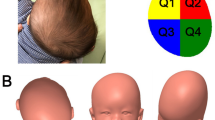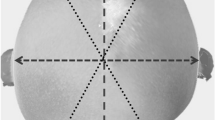Abstract
Purpose
This study aimed to investigate the effect of age at helmet therapy onset on treatment efficacy in moderate-to-severe deformational plagiocephaly (DP) and combined DP and asymmetrical brachycephaly (AB) in infants.
Methods
Ninety-eight infants who were referred to our institution and who underwent helmet therapy between 2014 and 2018 were retrospectively reviewed. Patients with DP [cranial vault asymmetry index (CVAI) > 7% and DD > 10 mm] and AB [CVAI > 7% and cephalic ratio (CR) ≥ 94] were included. Pre- and post-treatment calvarial asymmetries (difference among DD, CVAI, and CR) were measured using 3D screening systems (SmartSoc and Omega Scanner 3D). Infants were classified according to age at treatment onset: group 1 (age, < 6 months) and group 2 (age, ≥ 6 months).
Results
CVAI was statistically different between treatment onset and end in subgroups. Moreover, the regression of CVAI between groups DP1 (− 7.5% ± 1.2%) versus DP2 (− 5.4% ± 1.5%; p = 0.001) and groups AB1 (− 6.6% ± 1.4%) versus AB2 (− 4.4 ± 2.5; p = 0.0013) was statistically significant. CVAI was < 3.5% and CR was ≤ 89 (assumed as normal cranial shape) after treatment in 48%, 40%, 32%, and 6% of infants in groups DP1, DP2, AB1, and AB2, respectively.
Conclusion
These findings emphasize the efficacy of helmet therapy for DP and AB. Helmet is an appropriate treatment option particularly for infants with severe DP and AB, and early onset of helmet therapy before the age of 6 months is advised.


Similar content being viewed by others
Abbreviations
- AB:
-
Asymmetric brachycephaly
- AP:
-
Anterior-posterior, cranial width
- CR:
-
Cephalic ratio
- CVAI:
-
Cranial vault asymmetry index
- DD:
-
Diagonal distance
- C/S:
-
Cesarean section
- DP:
-
Deformational plagiocephaly
- FDA:
-
US Food and Drug Administration
- MCU:
-
Measurement and Comparison Utility
- ML:
-
Medial-lateral, cranial length
- NVD:
-
Natural vaginal delivery
- RSI:
-
Radial symmetry index
- 3D:
-
Three-dimensional
References
American Academy of Pediatrics AAP Task Force on Infant Positioning and SIDS (1992) Positioning and SIDS. Pediatrics 89:1120–1126
Argenta LC, David LR, Wilson JA, Bell WO (1996) An increase in infant cranial deformity with supine sleeping position. J Craniofac Surg 7:5–11. https://doi.org/10.1097/00001665-199601000-00005
Boere-Boonekamp MM, van der Linden-Kuiper LT (2001) Positional preference: prevalence in infants and follow-up after two years. Pediatrics 107:339–343. https://doi.org/10.1054/peds.107.2.339
Collett B, Breiger D, King D, Cunningham M, Speltz M (2005) Neurodevelopmental implications of “deformational” plagiocephaly. J Dev Behav Pediatr 26:379–389
Loveday BP, de Chalain TB (2001) Active counterpositioning or orthotic device to treat positional plagiocephaly? J Craniofac Surg 12:308–313. https://doi.org/10.1097/00001665-200107000-00003
Xia JJ, Kennedy KA, Teichgraeber JF, Wu KQ, Baumgartner JB, Gateno J (2008) Nonsurgical treatment of deformational plagiocephaly: a systematic review. Arch Pediatr Adolesc Med 162:719–727. https://doi.org/10.1001/archpedi.162.8.719
Kluba S, Kraut W, Reinert S, Krimmel M (2011) What is the optimal time to start helmet therapy in positional plagiocephaly? Plast Reconstr Surg 128:492–498. https://doi.org/10.1097/PRS.0b013e31821b62d6
Thompson JT, David LR, Wood B, Argenta A, Simpson J, Argenta LC (2009) Outcome analysis of helmet therapy for positional plagiocephaly using a three-dimensional surface scanning laser. J Craniofac Surg 20:362–365. https://doi.org/10.1097/SCS.0b013e3181992382
Clarren SK (1981) Plagiocephaly and torticollis: etiology, natural history, and helmet treatment. J Pediatr 98:92–95. https://doi.org/10.1016/s0022-3476(81)80549-5
Graham JM Jr, Gomez M, Halberg A, Earl DL, Kreutzman JT, Cui J, Guo X (2005) Management of deformational plagiocephaly: repositioning versus orthotic therapy. J Pediatr 146:258–262. https://doi.org/10.1016/j.jpeds.2004.10.016
Littlefield TR, Beals SP, Manwaring KH, Pomatto JK, Joganic EF, Golden KA, Ripley CE (1998) Treatment of craniofacial asymmetry with dynamic orthotic cranioplasty. J Craniofac Surg 9:11–17,discussion 18-19. https://doi.org/10.1097/00001665-199801000-00004
Mulliken JB, Vander Woude DL, Hansen M, LaBrie RA, Scott RM (1999) Analysis of posterior plagiocephaly: deformational versus synostotic. Plast Reconstr Surg 103:371–380. https://doi.org/10.1097/00006534-199902000-00003
Pollack IF, Losken HW, Fasick P (1997) Diagnosis and management of posterior plagiocephaly. Pediatrics 99:180–185. https://doi.org/10.1542/peds.99.2.180
Teichgraeber JF, Seymour-Dempsey K, Baumgartner JE, Xia JJ, Waller AL, Gateno J (2004) Molding helmet therapy in the treatment of brachycephaly and plagiocephaly. J Craniofac Surg 15:118–123. https://doi.org/10.1097/00001665-200401000-00031
Vles JS, Colla C, Weber JW, Beuls E, Wilmink J, Kingma H (2000) Helmet versus nonhelmet treatment in nonsynostotic positional posterior plagiocephaly. J Craniofac Surg 11:572–574. https://doi.org/10.1097/00001665-200011060-00010
Kelly KM, Littlefield TR, Pomatto JK, Manwaring KH, Beals SP (1999) Cranial growth unrestricted during treatment of deformational plagiocephaly. Pediatr Neurosurg 30:193–199. https://doi.org/10.1159/000028794
Kelly KM, Littlefield TR, Pomatto JK, Ripley CE, Beals SP, Joganic EF (1999) Importance of early recognition and treatment of deformational plagiocephaly with orthotic cranioplasty. Cleft Palate Craniofac J 36:127–130. https://doi.org/10.1597/1545-1569_1999_036_0127_ioerat_2.3.co_2
Lee RP, Teichgraeber JF, Baumgartner JE, Waller AL, English JD, Lasky RE, Miller CC, Gateno J, Xia JJ (2008) Long-term treatment effectiveness of molding helmet therapy in the correction of posterior deformational plagiocephaly: a five-year follow-up. Cleft Palate Craniofac J 45:240–245. https://doi.org/10.1597/06-210.1
Schaaf H, Pons-Kuehnemann J, Malik CY, Streckbein P, Preuss M, Howaldt HP, Wilbrand JF (2010) Accuracy of three-dimensional photogrammetric images in non-synostotic cranial deformities. Neuropediatrics. 41:24–29. https://doi.org/10.1055/s-0030-1255060
Freudlsperger C, Steinmacher S, Saure D, Bodem JP, Kuhle R, Hoffmann J, Engel M (2016) Impact of severity and therapy onset on helmet therapy in positional plagiocephaly. J Craniomaxillofac Surg 44:110–115. https://doi.org/10.1016/j.jcms.2015.11.016
Govaert B, Michels A, Colla C, van der Hulst R (2008) Molding therapy of positional plagiocephaly: subjective outcome and quality of life. J Craniofac Surg 19:56–58. https://doi.org/10.1097/SCS.0b013e31815c8a27
Lee MC, Hwang J, Kim YO, Shim KW, ParkEK LDH, Yun IS (2015) Three-dimensional analysis of cranial and facial asymmetry after helmet therapy for positional plagiocephaly. Childs Nerv Syst 31:1113–1120. https://doi.org/10.1007/s00381-015-2677-7
McKinney CM, Cunningham ML, Holt VL, Leroux B, Starr JR (2008) Characteristics of 2733 cases diagnosed with deformational plagiocephaly and changes in risk factors over time. Cleft Palate Craniofac J 45:208–216. https://doi.org/10.1597/06-227.1
Moss S (1997) Nonsurgical, nonorthotic treatment of occipital plagiocephaly: what is the natural history of the misshapen neonatal head? J Neurosurg 87:667–670. https://doi.org/10.3171/jns.1997.87.5.0667
Robinson S, Proctor M (2009) Diagnosis and management of deformational plagiocephaly. J Neurosurg Pediatr 3:284–295. https://doi.org/10.3171/2009.1.PEDS08330
Rogers GF, Mulliken J, Mulliken JB (2008) Comparison of a modifiable cranial cup versus repositioning and cervical stretching for the early correction of deformational posterior plagiocephaly. Plast Reconstr Surg 121:941–947. https://doi.org/10.1097/01.prs.0000299938.00229.3e
Seruya M, Oh AK, Taylor JH, Sauerhammer TM, Rogers GF (2013) Helmet treatment of deformational plagiocephaly: the relationship between age at initiation and rate of correction. Plast Reconstr Surg 131:55e–61e. https://doi.org/10.1097/PRS.0b013e3182729f11
Steinberg JP, Rawlani R, Humphries LS, Rawlani V, Vicari FA (2015) Effectiveness of conservative therapy and helmet therapy for positional cranial deformation. Plast Reconstr Surg 135:833–842. https://doi.org/10.1097/PRS.0000000000000955
Mackel CE, Bonnar M, Keeny H, Lipa BM, Hwang SW (2017) The role of age and initial deformation on final cranial asymmetry in infants with plagiocephaly treated with helmet therapy. Pediatr Neurosurg 52:318–322. https://doi.org/10.1159/000479326
Moghaddam MB, Brown TM, Clausen A, DaSilva T, Ho E, Forrest CR (2014) Outcome analysis after helmet therapy using 3D photogrammetry in patients with deformational plagiocephaly: the role of root mean square. J Plast Reconstr Aesthet Surg 67:159–165. https://doi.org/10.1016/j.bjps.2013.09.036
Wilbrand JF, Schmidtberg K, Bierther U, Streckbein P, Pons-Kuehnemann J, Christophis P, Hahn A, Schaaf H, Howaldt HP (2012) Clinical classification of infant nonsynostotic cranial deformity. J Pediatr 161:1120–1125. https://doi.org/10.1016/j.jpeds.2012.05.023
Author information
Authors and Affiliations
Corresponding author
Ethics declarations
The study was approved by the local ethics committee, and informed consent was obtained from every participant.
Conflict of interest
There is no conflict interest.
Additional information
Publisher’s note
Springer Nature remains neutral with regard to jurisdictional claims in published maps and institutional affiliations.
Rights and permissions
About this article
Cite this article
Çevik, S., Işık, S. & Özkılıç, A. The role of age on helmet therapy in deformational plagiocephaly and asymmetric brachycephaly. Childs Nerv Syst 36, 803–810 (2020). https://doi.org/10.1007/s00381-019-04354-2
Received:
Accepted:
Published:
Issue Date:
DOI: https://doi.org/10.1007/s00381-019-04354-2




